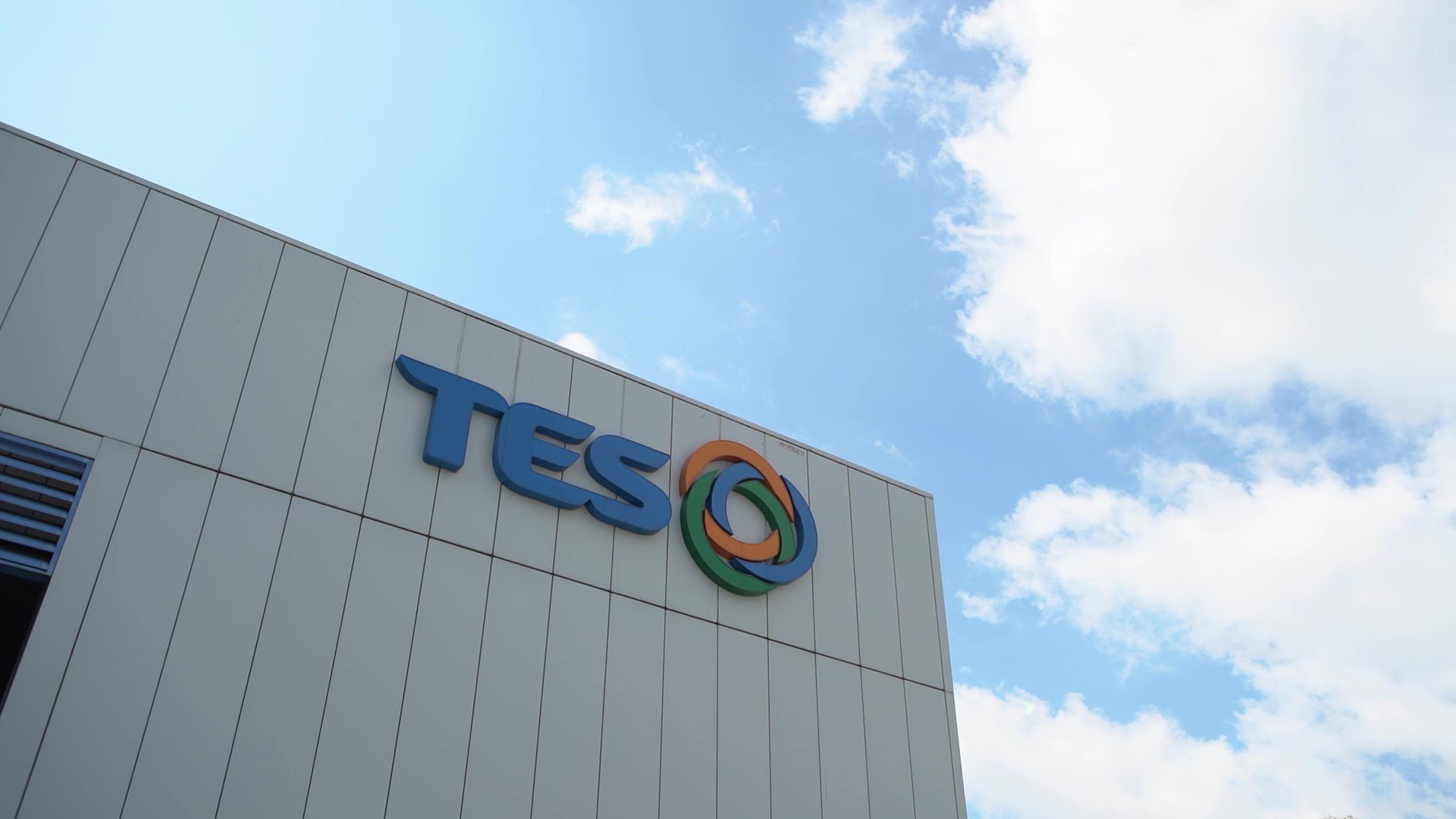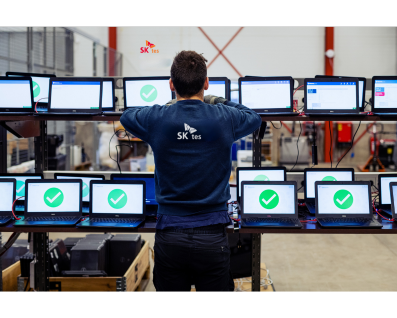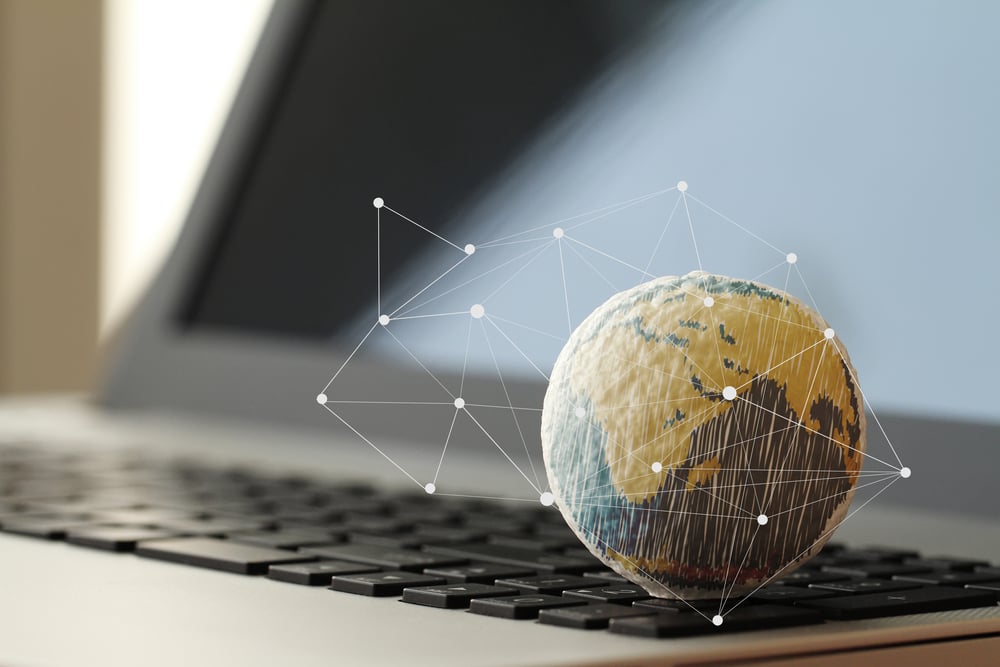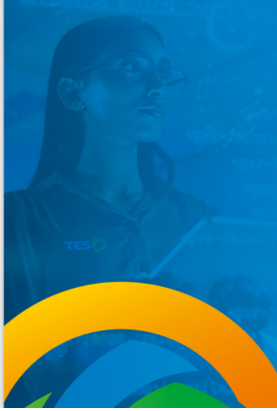

Our sustainability efforts acknowledged with an enhanced CDP reporting score, reflecting the...
MORE ABOUT SUSTAINABILITY

Whether you are deploying new equipment or re-deploying corporate IT equipment or enterprise data center technology, SK tes operates as a sustainable partner and trusted advisor helping you deliver your project responsibly.

Extend the lifecycle of your assets through repair and refurbishment for redeployment and resale. Once data has been securely erased your IT and networking technology can be resold, avoiding the purchase of new equipment. This avoids of GHG emissions and resource use associated with the raw material extraction, manufacturing and production required to create new electronics.
Learn about our IT Asset Disposition Programs
View options for component and spare part management and reuse

Contribute to creating circular economy for technology and eliminate waste with responsible electronics and battery recycling. SK tes recycling services facilitate closed loop and open loop materials use and regeneration of the environment.
We work with our clients to find higher end use applications for all resources, including hard to recycle, low value materials, to achieve maximum recovery levels. This approach minimizes pressure on natural resources.

SK tes helps clients meet sustainability objectives and initiatives with global technology and battery lifecycle solutions. By extending the lifespan of valuable assets and component parts, and through the recovery of raw materials by recycling, GHG emissions are avoided, reducing technology footprints for our clients and contributing to Scope 2 and Scope 3 emissions reduction goals.
Our services also contribute to progressing many of the UN's Sustainable Development Goals (SDGs).

SK tes is committed to operating with the highest possible environmental, social and governance (ESG) standards. We voluntarily report on our sustainability goals, timelines and progress in our annual Sustainability Report.
Transparent reporting demonstrates that we comply with labor, ethics, human rights and environmental regulations and best practice. Clients can rest assured that working with SK tes they are reducing the impact of their technology and battery use on people, communities and the planet.

SUSTAINABILITY

We recognize the importance of operating responsibly and having a positive impact on both society and the environment. We are convinced that by taking action now, we can work towards creating a better tomorrow for generations to come.
Our sustainability strategy is underpinned by three principle: protect, preserve and provide. We protect our customers' privacy, brand, intellectual property, and data, working to preserve our natural environment and promoting the responsible usage of scarce resources and we strive to provide a secure, diverse, and inclusive workplace and community where everyone can flourish.
SK tes takes the protection of its customers' privacy, brand, intellectual property, data and trust very seriously. To that end, the company is taking various actions to ensure that these aspects are safeguarded, including data and cyber security, responsible business operations and supply chains, legal compliance, promoting diversity and inclusion, minimizing environmental impact, and ensuring fair treatment of employees and suppliers.
We are taking action to protect our planet and its precious resources. By extending the life of assets, manage waste responsibly and taking responsibility for our impact on the environment and working to minimize it we are doing our part to preserve our planet for future generations.
SK tes is dedicated to creating a workplace and community that is safe, diverse, and inclusive, where everyone can flourish. We prioritize the safety of our employees, striving for zero injuries through our comprehensive health and safety management system, which is reinforced by ongoing training and a highly motivated workforce.

As leaders in the circular economy, we believe that balance between economic, environmental, and social responsibility is vital to long-term growth and that our success is directly related to the success of people and the planet.
We take a compliant, secure, and sustainable approach to meeting the technology management needs of organisations all over the world. Driving for maximum circularity in technology and battery use means optimizing the use, reuse, and recycling of your IT and data center assets and batteries.
Increased circularity will reduce waste and minimize the need for emissions-heavy production of new materials. The benefits are clear: By reducing reliance on new industrial materials and including a materials transition in our net zero implementation plans, we can move collectively toward a more responsible circular economy.

The Sustainable Development Goals (SDGs) serve as a crucial benchmark to evaluate our efforts in remaining pertinent and beneficial to our surroundings and the people we impact. Our organization has pinpointed 8 SDGs that align with our goals, competencies, and aspirations.
These SDGs are at the forefront of our focus as we strive to sustain our tomorrow:

At SK tes, we understand the importance of our role in instigating change, and we are committed to setting an example for others to follow. We have taken a global pledge to reach net zero greenhouse gas (GHG) emissions and have established science-based objectives to achieve this in the near future.
We are committed to reducing our emissions and ensuring that our future business growth is decoupled from our emissions.

SK tes has made a commitment to reducing their company-wide emissions in the near and long term. We have pledged to meet the SBTi Net-Zero Standard, which aligns with the requirements set by climate science.
In response to the call for corporate climate action from the SBTi, SK tes is adopting the targets set forth by the Business Ambition for the 1.5°C campaign. This is an important step towards mitigating the negative impacts of climate change and ensuring a sustainable future for our planet.

Our commitment to sustainability is grounded in our 17 Sustainable Impact Goals (SIGs), which serve as a blueprint for our efforts to combat climate change, promote responsible business and production. We are dedicated to Sustaining Tomorrow by keeping resources and materials in circulation, thus ensuring that future generations have access to the world’s resources.
Our technology management solutions are designed to help our clients reduce the need for replacement and maximize return on investment. We also promote the reuse and repurposing of assets by transforming and recycling end-of-life assets to recover primary materials and minimize waste.
We believe that by taking action today, we can help create a better tomorrow for future generations. Our strategy is to protect the privacy, brand, intellectual property, data and trust of our customers, preserve our natural environment and the use of scarce resources and provide a safe, diverse and inclusive workplace and community for people to thrive.
SK tes' commitment to sustainability includes engagement with independent auditors to validate the integrity, completeness and accuracy of our Sustainability Reporting. In alignment with our commitment to transparency and integrity in our sustainability initiatives, we recognise the necessity and importance of external assurance.
Our Sustainability Reporting undergoes external assurance by SGS International Certification Services and the protocols used to conduct assurance are based on the principles of the Global Reporting Initiative Sustainability Reporting Standards.
SK tes is a community member of the Global Reporting Initiative (GRI).

As leaders in the circular economy, we believe that balance between economic, environmental, and social responsibility is vital to long-term growth and that our success is directly related to the success of people and the planet.
We take a compliant, secure, and sustainable approach to meeting the technology management needs of organisations all over the world. Driving for maximum circularity in technology and battery use means optimizing the use, reuse, and recycling of your IT and data center assets and batteries.
Increased circularity will reduce waste and minimize the need for emissions-heavy production of new materials. The benefits are clear: By reducing reliance on new industrial materials and including a materials transition in our net zero implementation plans, we can move collectively toward a more responsible circular economy.

The Sustainable Development Goals (SDGs) serve as a crucial benchmark to evaluate our efforts in remaining pertinent and beneficial to our surroundings and the people we impact. Our organization has pinpointed 8 SDGs that align with our goals, competencies, and aspirations.
These SDGs are at the forefront of our focus as we strive to sustain our tomorrow:

At SK tes, we understand the importance of our role in instigating change, and we are committed to setting an example for others to follow. We have taken a global pledge to reach net zero greenhouse gas (GHG) emissions and have established science-based objectives to achieve this in the near future.
We are committed to reducing our emissions and ensuring that our future business growth is decoupled from our emissions.

SK tes has made a commitment to reducing their company-wide emissions in the near and long term. We have pledged to meet the SBTi Net-Zero Standard, which aligns with the requirements set by climate science.
In response to the call for corporate climate action from the SBTi, SK tes is adopting the targets set forth by the Business Ambition for the 1.5°C campaign. This is an important step towards mitigating the negative impacts of climate change and ensuring a sustainable future for our planet.

Our commitment to sustainability is grounded in our 17 Sustainable Impact Goals (SIGs), which serve as a blueprint for our efforts to combat climate change, promote responsible business and production. We are dedicated to Sustaining Tomorrow by keeping resources and materials in circulation, thus ensuring that future generations have access to the world’s resources.
Our technology management solutions are designed to help our clients reduce the need for replacement and maximize return on investment. We also promote the reuse and repurposing of assets by transforming and recycling end-of-life assets to recover primary materials and minimize waste.
We believe that by taking action today, we can help create a better tomorrow for future generations. Our strategy is to protect the privacy, brand, intellectual property, data and trust of our customers, preserve our natural environment and the use of scarce resources and provide a safe, diverse and inclusive workplace and community for people to thrive.
SK tes' commitment to sustainability includes engagement with independent auditors to validate the integrity, completeness and accuracy of our Sustainability Reporting. In alignment with our commitment to transparency and integrity in our sustainability initiatives, we recognise the necessity and importance of external assurance.
Our Sustainability Reporting undergoes external assurance by SGS International Certification Services and the protocols used to conduct assurance are based on the principles of the Global Reporting Initiative Sustainability Reporting Standards.
SK tes is a community member of the Global Reporting Initiative (GRI).
40+ sites in over 20 counties
of material processed annually
recovery rate
assets processed annually
By properly managing IT asset disposition (ITAD), companies can contribute to their sustainability goals in several ways.
ITAD helps to conserve natural resources by extending the lifecycle of electronic devices. Rather than discarding old devices and purchasing new ones, companies can refurbish and redeploy or resell them, reducing the need for new manufacturing and the associated GHG emissions and consumption of scarce resources.
By responsibly recycling any electronic waste that is not suitable for reuse, ITAD helps to divert harmful materials from landfills. Many electronic devices contain hazardous materials such as lead, mercury, and cadmium, which can pollute soil and water if not disposed of properly. By recycling these materials, companies can reduce the amount of pollution and waste generated, thereby contributing to a cleaner environment.
As technology continues to advance, electronic waste (e-waste) has become a major environmental concern. E-waste contains hazardous materials that can be harmful to humans and the environment if not managed properly.
You can ensure that your ewaste is managed sustainably by using a responsible IT asset disposition (ITAD) service provider. Your ITAD provider should work with you to maximize opportunities for equipment reuse and redeployment. This reduces the amount of e-waste in landfills and extends the lifecycle of electronics.
Businesses should keep track of their e-waste to ensure that it is properly disposed of or recycled. This can be done by keeping a log of all electronics that are disposed of or recycled.Reduction of CO2: Up to 15 Mt CO2 annually can be avoided through professional refurbishment and reusing technology through redeployment and remarketing.
Revenue: Up to $10 billion annually can be saved through properly designed reuse options, according to UN calculations.
Reduction of raw material mining: Extending the technology lifecycle avoids the need for more raw material extraction.
Proper recycling reduces the amount of e-waste in landfills. E-waste contains toxic substances such as lead, mercury, and cadmium, which can harm the environment and human health. By recycling e-waste, these harmful substances can be safely disposed of, reducing their negative impact on the environment.
Ecological impact can be reduced through the recovery of primary materials. Raw materials that can be recovered through responsible recycling of corporate IT equipment, enterprise data center assets and battery technology include copper, iron, aluminum, cobalt, tin and silver.
Electric vehicle and technology batteries are made up of various valuable materials such as metals, plastics, and chemicals, which can be harmful to the environment if not disposed of properly. Recycling lithium-ion batteries not only reduces the amount of waste that ends up in landfills but also helps in the conservation of scarce natural resources such as cobalt and lithium.
SK tes is focused on closing the loop on IT, data center technology and battery use through redeployment, reuse, resale and responsible recycling.
Extending the lifespan of technology assets through redeployment or reuse responsible recycling and properly disposing of end-of-life electronic waste in an environmentally-friendly way. This includes recycling batteries, which can be a significant source of pollution if not disposed of properly.
Closing the loop on technology use is not only environmentally responsible but can also provide economic benefits to companies and organizations. By taking a proactive approach to reducing electronic waste, we can help ensure a sustainable future for generations to come.
Using technology for an extended period of time can help reduce carbon dioxide equivalent (CO2e) emissions and contribute to a more sustainable environment. The reuse of a laptop can save up to 80% of the CO2e emissions that would be generated if a new laptop was purchased. This is because the production of a new laptop requires a significant amount of energy and resources, including the extraction of raw materials, manufacturing, and transportation.
In addition to reducing CO2e emissions, reusing a laptop can also have economic benefits. By extending the lifespan of a laptop, individuals and businesses can save money on purchasing new devices. It also reduces the amount of electronic waste that ends up in landfills, which can have negative environmental impacts.
Our latest Sustainability Report highlights our continued commitment to sustainable practices and progress towards achieving our sustainability goals.
Read more about our mission to make a decade of difference by securely and sustainability repurpose a billion kilograms of technology assets by 2030.
Stay up to date with sustainability and recycling policies, procedures and best practices, latest initiatives, technologies and solutions.


Our sustainability efforts acknowledged with an enhanced CDP reporting score, reflecting the...


We are delighted to release our 2022 Sustainability Report, detailing our progress towards our...